Neon Pothos Care and Propagation Guide

Neon Pothos is characterized by its bright neon green leaves. The zingy Neon Pothos plant is durable like other variations of Pothos, with the extra bonus of literally brightening up your room. Neon Pothos looks best when you display it as a hanging plant. Below, you will find handy information about Neon Pothos propagation, Neon Pothos care, and more.
Neon Pothos’ Scientific Name
As a vibrant variety of Golden Pothos, Neon Pothos’ scientific name is Epipremnum Aureum. However, this name is mainly used in the US and Canada. In Europe, Neon Pothos’ scientific name is Scindapsus aureus; and its previous botanical name is Phaphidophora.
Apart from Neon Pothos’ scientific name and its common name, you may also hear people naming it as Devils Ivy, Ivy Arum, or Ceylon Creeper too.
Neon Pothos Plant Description
Neon Pothos has heart-shaped leaves with eye-catching neon green or golden yellow color and no variegation. As the neon pothos plant ages, the color of its leaves darken. Neon Pothos can grow up to 20 inches long outdoors. Indoors, they are usually smaller and around 5 inches long.
Similar to other types of Pothos, the Neon Pothos plant is a vine that grows over time. But you can still manage its growth pattern by trimming or using a vertical structural for support. Since this plant is very forgiving, Neon Pothos’ care is very easy (as we will explain), making it a perfect houseplant for beginners.
Growing to a height of 60 inches, Epipremnum Aureum blossoms too. If you do not see a flower, remember that it can only flower when it reaches maturity in the right environment and has enough light. Just remember that it is toxic to pets and mildly toxic to humans if ingested.
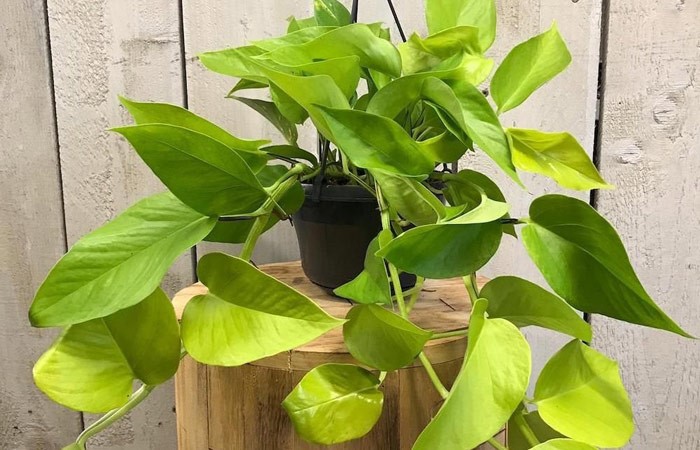
Neon Pothos Benefits
In addition to their chartreuse-green leaves and convenience for caring, Neon Pothos is highly effective at filtering airborne toxins such as benzene and formaldehyde found in paint, carpeting, and even insulation.
Neon Pothos plant replaces these toxins with oxygen and keeps the air around fresh and healthy. They are great for cleaning the air in parking areas or lift lobbies.
Neon Pothos’ Care
Neon Pothos plant is truly low maintenance. In the following, you will find all the information you need about how to take care of Neon Pothos.
Water
Regarding the watering needs, simply water your Neon Pothos plant to keep its soil moist. It is a good idea to have a watering schedule to avoid over-watering or under-watering. If you ever missed a date in the schedule, it is ok. Neon Pothos can tolerate it. However, do not water it so much that its soil becomes soggy.
If your Neon Pothos plant sits in soggy soil, it will wilt and its leaves will turn yellow. The trick for decreasing the risk of root rot is to let the plant drain after each irrigation and empty the tray under the pot as well. We also recommend using containers with drainage holes so the excess water cannot damage your Neon Pothos.
Under-watering will cause certain issues too, including curled up and lifeless leaves that will probably drop off. Neon Pothos roots should remain moist, but you should not allow it to be flooded between each irrigation. This Epipremnum Aureum variety prefers to dry the soil before you water it. So once the top 2 inches of soil is dry, it is time to water your plant again.
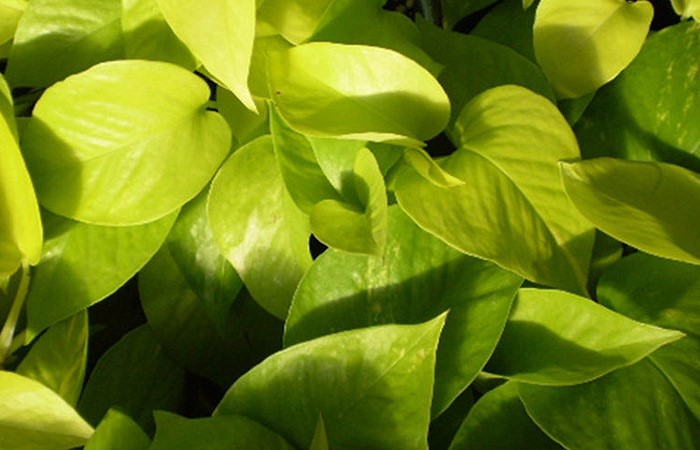
Soil
Providing high-quality soil for your plant is an important key in Neon Pothos’ care. When you buy a Neon Pothos plant, it is probably planted in a small pot. how to repot a cactus؟ As this impressive plant grows, you will need to repot it. If you want to grow your Pothos outdoors, make sure to provide it with efficient and moist soil. To grow the Neon Pothos indoor, remember that it thrives best in a pot with soil that is regularly drained well.
So choose an average, well-draining potting soil for the best Neon Pothos plant performance. This houseplant prefers a soil pH of 6.1 to 6.5 but will not have a strong reaction if the soil pH is slightly below this range.
After planting your Epipremnum Aureum Neon, pick a pot with sufficient drainage. The combination of fine well-drained soil with a high nutritional value will improve the growth of your striking plant as well as any other.
Tip: Although you can grow Neon Pothos plants in water jars, their roots will respond negatively when you transfer them to soil and over-watered. Water grown Neon Pothos will grow, but not as quickly as the ones you grow in the soil.
Light
Neon Pothos can grow in locations with low light but performs best in bright locations with indirect light throughout the year. Neon Pothos turning yellow and pale is the sign of too little sunlight, and burnt leaves are caused by harsh, intense sunlight.
We recommend positioning your Neon Pothos plant in a place near the window with bright and indirect sunlight. Do not put it in a dark room or dark corner, as the leaves will lose their pleasant variegation. Not enough light will damage the development and health of your Pothos.
Humidity
Providing the right amount of humidity is essential in Neon Pothos’ care too. This houseplant grows best in high humidity, making it an excellent plant for bathrooms or kitchens. You can place it in your room as well, but it is a better idea to keep it in a slightly more humid setting.
In Neon Pothos’ care, brown leaf tips can indicate that the humidity is very low. Since we are talking about a hardy houseplant, it is no surprise that it can survive in dry atmospheres. However, since they are tropical plants, obviously they favor high humidity conditions more.
If your plant seems worn because of the lack of moisture, fill the saucer with pebbles and water. Place the Neon Pothos plant on the pebbles, but make sure to have drain holes, and the pot base is not immersed in water. Misting every week or every two weeks also helps improving humidity requirements.
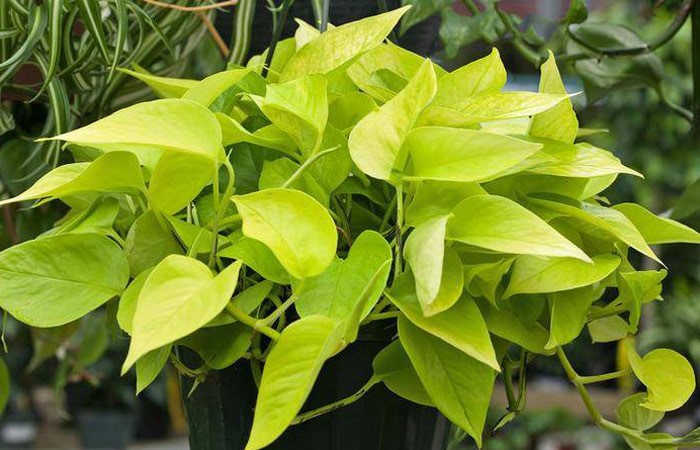
Temperature
Neon Pothos plant is native to the Solomon Islands. Therefore, it enjoys high humidity and temperatures between 70 and 90 °F. Make sure that you place your attractive Epipremnum Aureum Neon within this range of temperatures.
This durable houseplant thrives and grows faster in such temperatures. But, it can also tolerate temperatures as low as 55 °F. If the temperature goes below that, you will see that your Neon Pothos has sluggish growth and it leaves begin to darken.
Feeding
To enjoy Neon Pothos’ benefits and its bright eye-catching color, it is a good idea to fertilize your plant every 2 or 3 months, especially during the growth period.
If planted in proper soil, the Neon Pothos plant will do just great without any fertilization. However, fertilizing according to the instruction will maximize its rate of growth and ensure that your plant grows and develops as rapidly as possible.
Use a healthy, houseplant fertilizer for feeding your Epipremnum Aureum. If you cannot decide whether the soil needs fertilizer or not, evaluate it. To do so, look for gardening shops that offer home soil testing kits. These useful kits determine exactly what nutrients are present or missing in the soil.
There are different fertilizers providing all the nutrients that this plant needs for thriving and growing. If use decided to use organic fertilizers, keep in mind that they take more time to stimulate plant growth. Instead, they maintain a healthier medium of production. On the other hand, inorganic fertilizers offer a significant nutrient enhancement to the soil, enhancing the growth of the Neon Pothos plant significantly.
Organic or inorganic, make sure to read the fertilizer package details to use the right amount for the size of the container that your Neon Pothos plant is growing in.
Pruning
Knowing how to prune this lovely plant is another important part of Neon Pothos’ care. The cutting method is an easy way to trim this bright houseplant. It is beneficial if you always cut the vine a few inches above each leaf. This region is called a node, where the leaf joins the vine. When you prune your Epipremnum Aureum vines, it will send a new vine out in that field.
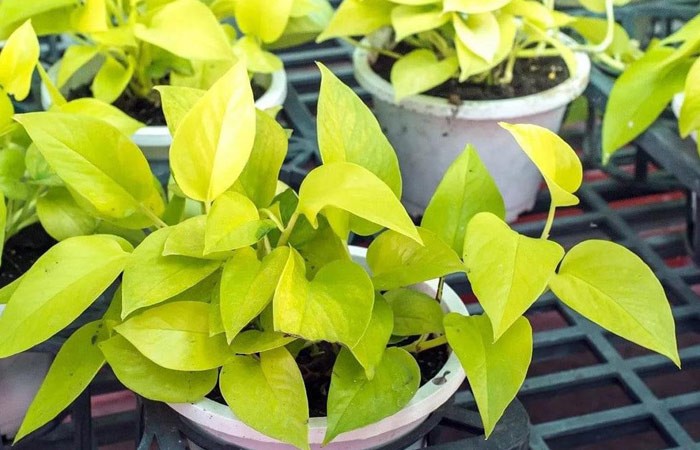
Neon Pothos Propagation
Like other things that are related to this unique houseplant, Neon Pothos propagation is done with the least amount of effort as well. In the following, you are going to see how to propagate Neon Pothos step by step:
- We suggest Neon Pothos propagation using the stem cutting method. For this method, first, you need to cut the vines into small pieces.
- Remove the bottom leaf to reveal the node and put it in a pot or spread station with water.
- For a successful Neon Pothos propagation, make sure the bare node is under the water and the leaves above water. Also, make sure each stem cutting has one or two leaves.
- Soon, fresh roots will start to grow in the nodes. When the roots are about 1 inch long, it is time to plant them in soil.
- Now you can initiate a brand new Neon Pothos plant, or even plant it back in the main pot to create an impressive fuller plant.
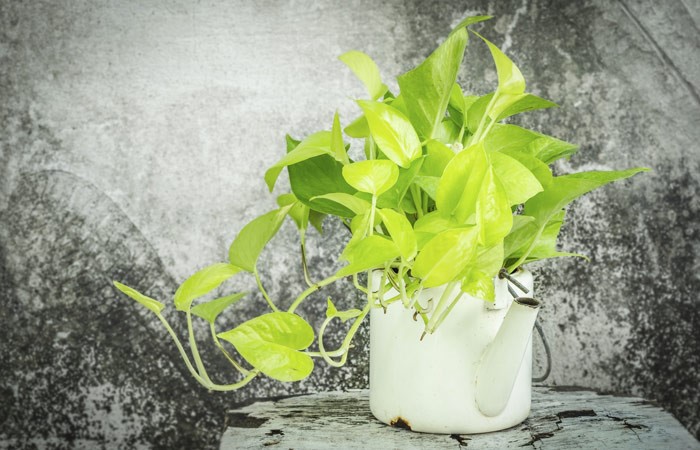
Common Issues in Neon Pothos Care
Now that you know everything on how to take care of Neon Pothos, it is good to have information about is common problems as well.
Neon Pothos Turning Green
If you notice that the leaves of your Neon Pothos are turning green (solid green), it is trying to tell you that it is not getting enough light. Low light for this plant leads to greener and smaller leaves.
Neon Pothos Turning Yellow
In addition to Neon Pothos turning green, Neon Pothos turning yellow is a common issue among the owners of this Golden Pothos variety. Neon Pothos turning yellow can have different reasons.
Improper Moisture
The most common reason causing Neon Pothos to turn yellow is improper soil moisture, especially over-watering. As we mentioned in the Neon Pothos care part, the soil should be damp, but not soggy. However, in the winter you can let your plant dry out a little more between irrigations. However, increase the humidity with regular misting, pebble tray, or a humidifier.
When you watering your plant, provide enough water so that it flows from the pot drainage hole(s) into the saucer under it. Do not forget to discard the excess water in the saucer immediately to avoid further issues, including root rot and even the death of the Neon Pothos plant.
Improper Humidity Level
Low humidity and dry soil can cause Neon Pothos to turn yellow, and brown on the leaves edges, followed by entire yellowing, browning, and leaf drop. To stop this problem, mist the leaves regularly to increase the humidity.
Improper Light
As we explained the light requirements in Neon Pothos’ care, this plant performs best when in bright to medium indirect sunlight, also adapting to lower light. But if you put it in very low light, you will notice Neon Pothos turning yellow. Exposing this charming houseplant to direct sunlight for too long will burn the foliage as well.
Neon Pothos Pests
Pests can make serious problems for weakened Neon Pothos plants. Pests like spider mites that drain the moisture, will cause yellowing of the leaflets and fronds. These pests often occur in indoor conditions. If not killed early stages, these pests will move all along stems and leaves. They will exhaust your plant and increase yellowing, especially if your plant is already stressed from improper lighting, feeding, or soil moisture.
Natural Cases
If there is new growth on your house plant and the yellowing leaves are older, especially at the bottom of it, the Neon Pothos turning yellow is natural. In this case, your plant is simply shedding its old leaves and saves energy to grow new ones.
Hopefully, this information will help you to grow this bright and striking plant at your home. Happy gardening!
- In this post:
- Neon Pothos’ Scientific Name
- Neon Pothos Plant Description
- Neon Pothos Benefits
- Neon Pothos’ Care
- Neon Pothos Propagation
- Common Issues in Neon Pothos Care



